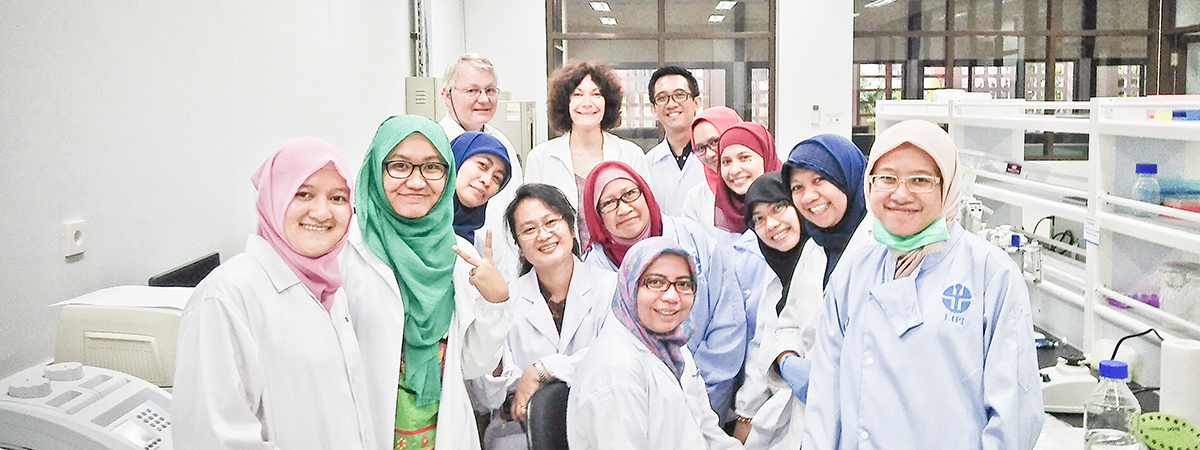For drug discovery to be successful, projects with an international scope play a particularly important role, since they make the large biological diversity of unusual habitats accessible.
"We have recently obtained so many new and untapped microorganisms and fungi with interesting biological activities that we are finding it hard to prioritise their evaluation," says Prof Marc Stadler, head of the "Microbial Drugs" department at the Helmholtz Centre for Infection Research (HZI). The already quite extensive natural compound library of the HZI is based on the world-wide largest collection of myxobacteria. These soil-dwelling bacteria produce chemical substances and use them to protect themselves from other microorganisms. The discovery of several new genera and families and the expansion of the collection have resulted in particular from the work done at the Helmholtz Institute for Pharmaceutical Research Saarland (HIPS) directed by Prof Rolf Müller. Since 2012, the in-house strain collection of the HZI has been expanded specifically through international co-operations. Aside from myxobacteria, new species of rare actinobacteria and fungi are also in the focus of this work.
GINAICO is one of the ongoing cooperation projects, in which scientists from Indonesia and Germany aim to find natural substances with antibiotic activity from the rich biological potential of Indonesia. GINAICO, or "German Indonesian Anti-Infectives Cooperation", has been funded by the German Federal Ministry for Education and Research (BMBF) since 2015. Still in its infancy, the co-operation between German and Indonesian scientists already bears its first fruit: "We have already identified some new species of microorganisms and are working on the first producers of potent antibiotic agents," says Dr Joachim Wink, who is the project leader and head of the "Microbial Strain Collection" research group at the HZI.
Upon the introduction of international guidelines, such as the "Convention on Biological Diversity" (CBD) and the Nagoya protocol, recently ratified by the European Union, the fair and mutual utilisation of biological resources in the scope of international partnerships, especially with emerging nations, has shifted more into the focus of the public. The exchange of expertise and resources related to biodiversity as well as the joint training of young scientists aim to promote the networking of drug researchers throughout the world. "In the scope of GINAICO, we organised seminars, conferences and a laboratory workshop in Indonesia," says Wink. "In some countries, such as Indonesia, Thailand or Iran, some of the laboratories have very good equipment. But often, there is a lack of staff that can operate this equipment. This is where we can help with training sessions and staff exchanges." In addition, international junior researchers visit the HZI on stipends from the project funds. Guest researchers at the HZI laboratories will get familiar with, for example, isolation and cultivation techniques for novel bacteria from soil samples and the gastrointestinal tracts of animals as well as the taxonomic characterisation of these microorganisms and their fermentation for the production of antibiotics and other metabolites.
Some other international projects focus more on fungi. Those include, e.g., the "Golden Mycological Triangle" project that is funded as part of the "Research and Innovation Staff Exchange" (H2020-RISE) research programme of the EU. Aside from the HZI, the renowned BIOTEC research centre in Thailand and the Dutch Westerdijk Fungal Biodiversity Institute (formerly named CBS) are partners in this co-operation. These research facilities are engaged in a joint search for new candidate antibiotics in insect-associated and endophytic fungi. This project already allowed several junior scientists from the HZI to go on research visits to Thailand for several months to expand their knowledge of the pertinent methodology. In the scope of the sciences and technology cooperation project of the EU with the African continent called ERAFRICA, HZI scientists and their colleagues from Kenya and South Africa are also studying fungi associated with African plants (ERAFRICA programme ASAFEM: "Antibiotics and anti-quorum sensing compounds from African fungal endophytes inhabiting medicinal plants and cultures of macromycetes").
The first new agents from these projects are already being fermented in bioreactors at a substantial scale at the HZI. The equipment used for this purpose was purchased by the researchers in 2016 using funds they raised through the "AntiMalariaDrug" project funded by the BMBF. The visiting scientists from the countries of origin participate in the isolation of antibiotics that are being produced using the new bioreactors. Concurrently, the scientists collected valuable information about the biodiversity at the countries of origin in the scope of these projects and will publish this information in leading professional magazines jointly with their cooperation partners.
"The expertise we transfer to the researchers visiting the HZI improves their job prospects in their home countries," says Marc Stadler. But the international co-operation also boosts the work of the HZI researchers as it allows them to work on many innovative sources of new anti-infectives. "We are one of the leading institutions in the discovery and characterisation of natural products world-wide," Stadler says. He and Joachim Wink aim to further expand the international, interdisciplinary scope of their research and secure the existing co-operations in the medium- and long-term. In our times of globalisation, natural products research can be successful only in the scope of extensive international networks.
Read more about the project GINAICO in the current issue of the HZI staff magazine „InFact“: https://www.helmholtz-hzi.de/en/news_events/thema/no_borders/
Further information:
Nagoya protocol
ERAFRICA programme ASAFEM
RISE project „Golden Mycological Triangle“
RISE-Project
Press release about the BMBF project “AntiMalariaDrug“
Original publication:
C. Chepkirui, C. Richter, J. C. Matasyoh, M. Stadler: Monochlorinated calocerins A-D and 9-oxostrobilurin derivatives from the basidiomycete Favolaschia calocera. Phytochemistry, 2016, DOI: 10.1016/j.phytochem.2016.10.001.
C. M. Mudalungu, C. Richter, K. Wittstein, M. A. Abdalla, J. C. Matasyoh, M. Stadler, and R. D. Süssmuth: Laxitextines A and B, cyathane xylosides from the tropical fungus Laxitextum incrustatum. Journal of Natural Products, 2016, DOI: 10.1021/acs.jnatprod.5b00950.
C. Chepkirui, J. C. Matasyoh, C. Decock, M. Stadler: Two cytotoxic triterpenes from cultures of a Kenyan Laetiporus sp. (Basidiomycota). Phytochemistry Letters, 2017, in press, DOI: 10.1016/j.phytol.2017.04.009

